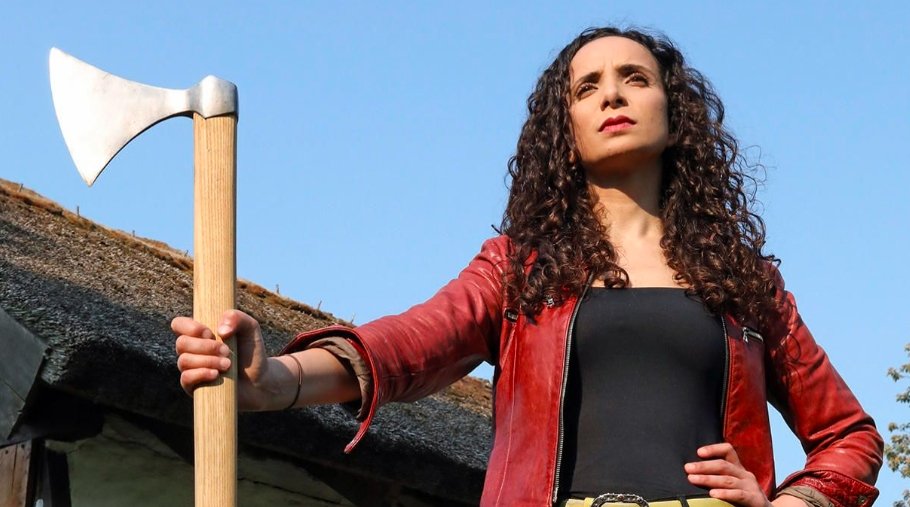In a quiet graveyard in the forested hills of Solør, Norway, archaeologists long puzzled over an ancient burial that refused to conform to expectations. Inside the 1,000-year-old Viking grave was the skeleton of a woman — but she wasn’t laid to rest with jewelry or domestic tools. Instead, she was surrounded by weapons: a sword, spear, axe, arrows, and a shield.
Now, thanks to cutting-edge 3D facial reconstruction technology, her face has been brought back to life — battle-scarred and defiant — forcing historians and skeptics alike to confront a long-disputed question: Were Viking women truly warriors?
A Skull With a Story to Tell
The woman’s grave has been known to archaeologists for years, but it wasn’t until recently that a team led by archaeologist and paleoanthropologist Ella Al-Shamahi decided to digitally reconstruct her face. What they found stunned even seasoned experts.
Her skull bore a deep, sword-like slash across the face — a violent wound that, had it been fresh, would have been instantly fatal. But a closer examination revealed something remarkable: signs of healing. This was no immediate cause of death, but an old injury — and evidence that she had survived at least one brutal encounter.
“This is the first concrete evidence of a Viking woman with a battle injury,” said Al-Shamahi in an interview ahead of the upcoming National Geographic documentary featuring the reconstruction. “She was hit in the face with a sword. She lived. She fought.”
The forensic reconstruction, created in partnership with Dr. Caroline Erolin of the University of Dundee, used cranial scans, muscle modeling, and digital layering techniques to rebuild her facial features. The result: a young woman with high cheekbones, solemn eyes — and a long scar slicing through her features.
“She’s suddenly become really real,” Al-Shamahi said. “This is a face no one has seen in 1,000 years.”

Warrior, Not Symbol
Skeptics have long dismissed evidence of female Viking warriors, suggesting that burials with weapons could be symbolic, or that remains may have been misidentified. But this latest find joins a growing body of research undermining those assumptions.
Notably, a 2017 DNA analysis of the famous Birka Warrior grave in Sweden — a burial long assumed to be male due to the array of weapons and horses interred — shocked the academic world when it confirmed the occupant was biologically female.
“There was a lot of resistance to the Birka Warrior being a woman,” said Viking historian Professor Neil Price, who served as an archaeological consultant on the new reconstruction. “That resistance was ideological, not scientific.”
In this case, there is no ambiguity. The Solør burial not only included a fully armed arsenal but now also reveals a healed battle wound, making it the most compelling physical evidence yet that women not only accompanied Vikings to war — they fought in them.
Fighting From Afar
Al-Shamahi, whose research focuses on human evolution and conflict, believes that assumptions about female warriors come down to underestimating tactical variety in Viking warfare.
“Of course male warriors had advantages in raw strength,” she said. “But Viking combat wasn’t just brute force. It was about strategy, mobility, and ranged attack.”
She points to long-distance weapons — bows and arrows, javelins — as likely areas where women may have excelled.
“Firing arrows from horseback or from behind a shield wall could have made women an equal match.”
This interpretation aligns with grave goods from the Solør site: multiple arrowheads were found at the burial, suggesting a preference or specialization in ranged combat.
From Skull to Screen
The reconstructed face, along with a digital recreation of the grave site, will debut in the forthcoming National Geographic documentary, which follows Al-Shamahi across Scandinavia as she investigates Viking burial practices, ancient combat, and shifting gender roles.
The project utilized advanced imaging and digital forensics to recreate not just the woman’s appearance but the entire burial chamber — weapons, bones, and all — offering a fully immersive look at the past brought into the present.
Dr. Erolin, who handled the reconstruction, is careful to note the limits of the process:
“The result isn’t a photograph,” she said. “It’s an approximation — but close enough that someone who knew her in life might recognize her.”
A Changing Historical Landscape
This discovery is part of a broader reckoning within Viking scholarship. For decades, the romanticized image of the Norse warrior has been overwhelmingly male: bearded raiders, sword-wielding berserkers, sea-hardened kings. But archaeological and genetic evidence is rapidly disrupting that narrative.
-
Weapon-filled female graves are turning up across Scandinavia.
-
Genetic analysis is confirming more female remains in traditionally male-associated burials.
-
Cultural reinterpretation is challenging biases in both historical texts and archaeological methodology.
“There are so many other burials in the Viking world,” said Price. “It wouldn’t surprise me at all if we find more women like her.”
And indeed, the evidence is mounting. Just like the woman from Solør, their stories are being unearthed — bone by bone, scar by scar.













